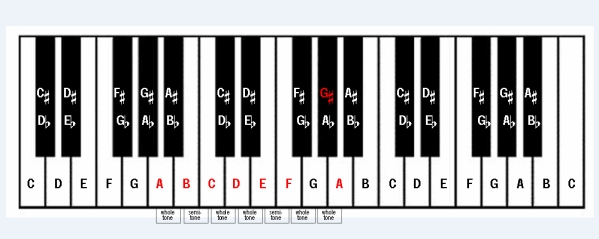Harmonic minor scales
Now that we have studied the natural minor scale, we will look at and listen to the harmonic minor scale. The sequence of intervals in A harmonic minor is as follows:
Step 1 – 2 (a – b): whole tone
Step 2 – 3 (b – c): semitone
Step 3 – 4 (c – d): whole tone
Step 4 – 5 (d – e): whole tone
Step 5 – 6 (e – f) semitone
Step 6 – 7 (f – g#) augmented second¹
Step 7 – 8 (g# – a) semitone
The only difference between the structure of the harmonic minor scale and the natural minor scale is the seventh step, which is raised in the harmonic minor to create a leading tone². This means that there is an unusually large and dissonant interval between the sixth and seventh steps – an augmented second. For this reason the harmonic minor scale, true to its name is typically used as the harmonic foundation of minor keys. This means that it forms the foundation of the chords used to enrich melodic lines. The keyboard below shows the structure of a harmonic minor. The seventh step has been raised from the g natural found in the natural minor scale to g#. In spite of this the scale still shares its key signature with C major. The g# is shown as an accidental within the music. The same rule applies to all harmonic minor scales: the seventh step is raised and shown as an accidental within the music score, but never in the key signature.
¹Augmented second: an interval consisting of three semitones. An augmented second is the same size interval as a minor third but is spelt differently. If we were to spell the augmented second in a harmonic minor as a minor third we would spell it either as E# – G# or F – Ab.
²Leading note: the seventh step of a scale always a major seventh above or a semitone below the tonic. When the seventh step of a scale is a minor seventh from the tonic it is called a subtonic rather than a leading tone.
Here’s a video diagram showing the first ascending octave of A harmonic minor on the cello. The augmented second requires an unusual extension from the second to the fourth fingers.
